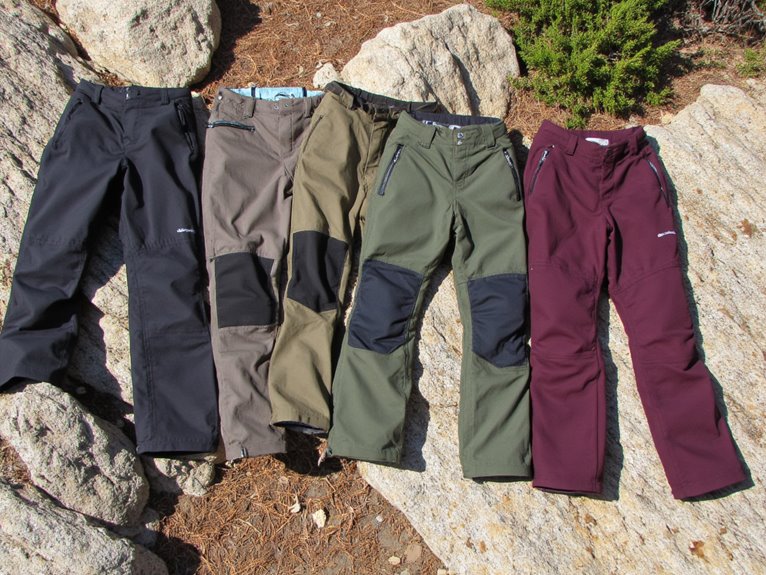How Many Kg Is a Full Backpack?
A full backpack can weigh anywhere from 15 kg to 40 kg, depending on the backpack model, trip type, and packing needs, with the majority of backpackers aiming to stay within the 15-20 kg range for ideal comfort and efficiency. The type of trip and packing needs greatly influence the ideal backpack weight, with hikers and campers often prioritizing lightweight gear. Understanding weight capacity, packing strategically, and adhering to airline and transport weight limits are vital for a hassle-free journey. As you prepare for your trip, consider the factors that affect backpack weight and aim for a balance between comfort and efficiency.
We are supported by our audience. When you purchase through links on our site, we may earn an affiliate commission, at no extra cost for you. Learn more. Last update on 25th December 2025 / Images from Amazon Product Advertising API.
Backpack Size and Weight Capacity
Backpack size and weight capacity are critical factors to ponder when determining how much a full backpack weighs, as they directly impact the amount of gear that can be carried safely and comfortably.
A larger backpack does not necessarily mean it can hold more weight, as the weight capacity is determined by the material, frame, and suspension system.
The weight capacity ranges from 15 kg to 40 kg, depending on the backpack model and brand.
It is vital to bear in mind the maximum weight capacity to avoid overloading, which can lead to discomfort, fatigue, and even damage to the backpack.
Understanding the weight capacity guarantees that the backpack is used efficiently and safely.
Type of Trip and Packing Needs
When preparing for a trip, the type of trip and packing needs play a significant role in determining the ideal backpack weight.
For instance, a trekker may prioritize packing only the essentials, such as a first-aid kit, map, and compass, whereas an urban traveler may require more comfort items, like a laptop and change of clothes.
Understanding the specific requirements of each trip type is vital in striking a balance between packing what's necessary and avoiding unnecessary weight.
Trekking Essentials Only
For multi-day treks, carefully curated essentials are vital to guarantee a comfortable and safe journey.
When packing for a trek, prioritize items that serve multiple purposes to minimize weight and bulk.
A waterproof and breathable tent, sleeping bag, and pad are must-haves.
Clothing should include moisture-wicking base layers, insulating mid-layers, and waterproof outerwear.
A first-aid kit, headlamp, and water purification tablets or filter are also essential.
Don't forget a multi-tool, camp stove, and fuel.
A portable camp chair and camp shoes can provide comfort during downtime.
Remember to pack high-calorie, lightweight food and a water bottle or hydration bladder.
Urban Traveler's Needs
Typically, urban travelers set out on shorter, more fast-paced trips, requiring a drastically different packing strategy that prioritizes versatility and convenience.
Urban travelers often focus on exploring cities, visiting attractions, and experiencing local cultures.
As a result, their packing needs are centered around comfort, practicality, and style. They require clothing that can be easily mixed and matched, as well as accessories that serve multiple purposes.
Essentials like a portable charger, travel adapter, and packing cubes become essential in maximizing space and minimizing hassle.
With a focus on urban exploration, the ideal backpack weight for urban travelers would be around 10-12 kg, allowing for a balanced blend of comfort, convenience, and mobility.
Hiking and Camping Gear Weight
When venturing into the wilderness, it's vital to strike a balance between packing the essentials and minimizing weight.
Hikers and campers can substantially reduce their load by opting for lightweight gear options, such as compact tents and sleeping bags.
Packing the Essentials
A well-packed backpack typically weighs between 15-20 kg, with a significant portion of this weight attributed to essential hiking and camping gear.
These must-haves include a tent, sleeping bag, sleeping pad, and backpacking stove, which collectively contribute around 5-7 kg to the overall weight.
A water filter or treatment, first aid kit, and navigation tools such as a compass and map add another 2-3 kg.
Clothing and personal items, including a change of clothes, socks, and undergarments, account for an additional 2-3 kg.
Finally, food and cooking supplies, including a camp stove, fuel, and utensils, weigh around 3-5 kg.
Lightweight Gear Options
By opting for lightweight gear options, hikers and campers can substantially reduce the weight of their backpacks, making their outdoor adventures more efficient and enjoyable.
This can be achieved by selecting gear that serves multiple purposes, such as a sleeping bag with a built-in pad, or a tent with a rain fly that doubles as a ground cloth.
Additionally, considering materials like nylon, polyester, or silicone can help reduce weight without compromising durability.
In addition, opting for smaller or compact versions of essential items, such as a portable stove or a water filter, can also contribute to a lighter load.
Total Weight Considerations
Total weight considerations play a vital role in backpacking, as every kilogram counts when carrying gear for extended periods, and a thorough understanding of the cumulative weight of hiking and camping equipment is essential for a comfortable and successful outdoor adventure.
When planning a trip, it's vital to think about the weight of individual items, as well as the total weight of the backpack.
- Pack weight: Aim for a pack weight of 15-20 kg for a comfortable hiking experience.
- Gear weight distribution: Balance the weight of gear between the pack, pockets, and wearable items to minimize fatigue.
- Weight-saving strategies: Opt for lightweight gear, compress items, and eliminate non-essential items to reduce overall weight, and it's essential to factor in the weight of every item to ensure a balanced and manageable load.
Traveler's Personal Item Allowance
Most airlines permit one personal item, such as a small backpack, purse, or laptop bag, to be carried on board in addition to a carry-on bag, with certain size and weight restrictions applying.
This personal item allowance is typically intended for small, essential items that can fit under the seat in front of you.
The maximum size for a personal item varies by airline, but it's usually around 18-20 inches tall, 14-16 inches wide, and 8-10 inches deep.
It's essential to check with your airline for their specific personal item size and weight restrictions to comply.
Airline and Transport Weight Limits
Understanding the weight restrictions imposed by airlines and transportation providers is vital to avoiding additional fees or even having luggage rejected at check-in. Exceeding the allowed weight limits can result in extra charges, which can quickly add up.
To avoid these unwanted surprises, it's essential to familiarize yourself with the weight limits of your chosen airline and transportation providers.
Checked luggage: Typically, airlines allow checked luggage to weigh between 20-32 kg (44-70 lbs).
Carry-on luggage: Most airlines restrict carry-on luggage to 7-10 kg (15-22 lbs).
Regional transportation: Bus and train operators often have their own weight limits, usually ranging from 20-50 kg (44-110 lbs).
Remember to always check with your airline or transportation provider for their specific weight limits to guarantee a hassle-free journey.
Packing Strategies for Optimal Weight
To guarantee that your backpack stays within the allowed weight limits while still packing everything you need for your trip, packing strategically is key to efficient weight distribution.
Start by categorizing essentials into must-haves, nice-to-haves, and luxuries. Prioritize the must-haves and allocate space accordingly.
Roll clothing to save space and reduce wrinkles. Utilize packing cubes or compression bags to compress items and keep them organized.
Place heavier items, like shoes, at the bottom of the backpack and balance them with lighter items on top.




